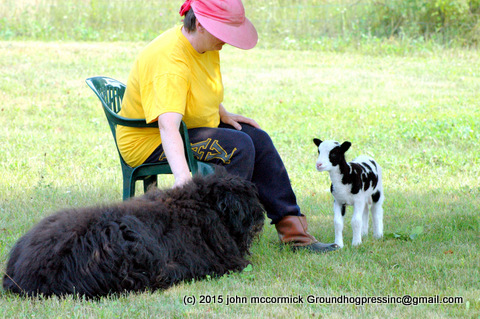The first study, on the previous page, measured the response of other dogs to tail wagging in general. The second study went into more detail. It shows the effect of tail docking.
The Second Dog Tail Length Study
The second study which caught my attention involved four robot dog conditions, long tail wagging, long tail still, short tail wagging, and short tail still.
I found the most interesting part of the second study was the fact that all the dogs tended to ignore what the short tail robot was doing – that is, whether it is wagging or not. The same dogs reacted very differently to the long tail robot when it wagged or didn’t wag.
That means that a docked tail is not seen as a part of body language and dogs with no tails are deprived of a communication tool.
The second study, “Behavioural responses of Canis familiaris to different tail lengths of a remotely-controlled life-size dog replica” S.D.A. Leaver & T.E. Reimchen, Department of Biology, University of Victoria, Victoria, B.C., Canada V8W 3N5.
To summarize the study (skipping lots and lots of unnecessary descriptions of dogs) the tails of dogs are used for communication. Docking a dog’s tail prevents that communication happening.
The researchers videotaped interactions of 492 free (off-leash) dogs and quantified size and behavior of approaching dogs to the model’s four tail conditions (short/still, short/wagging, long/still, long/wagging). The big dogs were, of course bolder and were more likely to approach a long/wagging tail rather than a long/still tail, but the big dogs did not pay any attention to whether or not the short tails were wagging or still – they treated both the same.
What Else Tail Docking Causes
Dogs also use tails for balance when running. With our Saint Weilers the one with no tail actually waggles her entire body from the hips back while the one with the hefty tail (these dogs have VERY robust tails such that I can pull her by the tail without any slight indication of discomfort – she doesn’t even look around) just wags her tail, not her entire body. As puppies in a loving home they both wag most of the time and it is very apparent that there is a big difference in how the tail or lack of it affects how they move.
To summarize, cutting your puppy’s tail is unnecessary, is done purely for cosmetic reasons, and will cause it problems dealing with other dogs when it is grown up. (Dogs, cats, and people all seem to recognize puppies as young and give them a break.)
[youtube width=”602″ height=”350″ video_id=”TE9nA2PyD4M”]






Although I grew up with German boxers and at that time they had docked tails and clipped ears, I never liked it and did not believe for one second that it did not hurt the puppies. I am surprised that it is still allowed in the States. And while it might be banned in most European countries you still see a lot of dogs with docked tails stemming from dog factories in Eastern European countries.
I’ve never liked the idea of tail docking, except when needed for some medical reason, and ear cutting is a terrible thing to do to an animal. People should be free to cut their own ears, if they want, but leave the dogs alone!
I never liked the idea of it, except that short tails don’t wipe out everything on the coffee table, but I didn’t realize it could affect the way a dog walks.